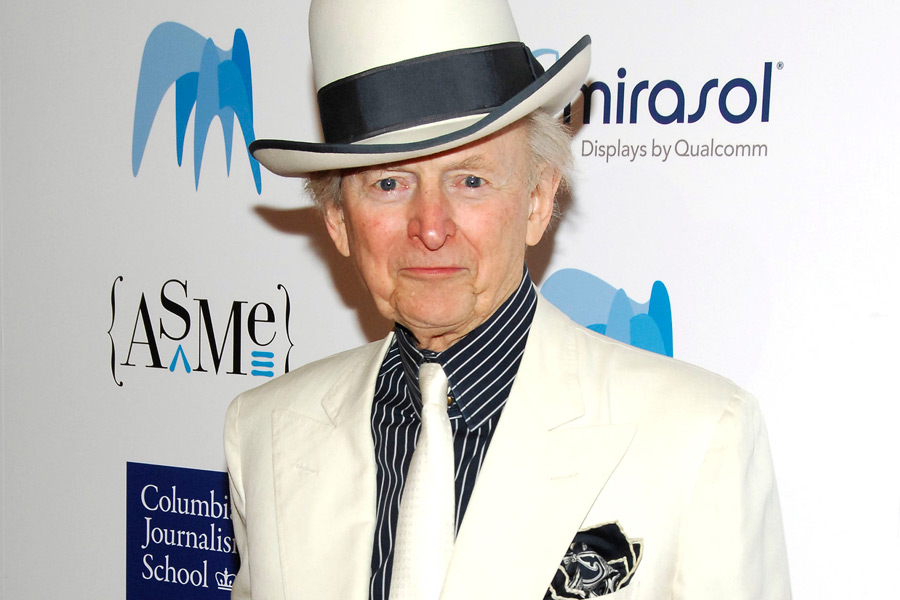Who's Here: Tom Wolfe, Author

Author Tom Wolfe has maintained a vacation home in Southampton for many years and is often at the Hampton Classic Horse Show, where his daughter sometimes competes.
He was born and raised in a well-to-do neighborhood in Richmond, Virginia. His parents both worked with nature. His father was an agronomist and his mother was a landscape designer. He went to Washington and Lee University near his home and there acquired his lifelong interest in literature. He was one of the founders of that school’s literary magazine, earned his Phi Beta Kappa key and graduated second in his class, cum laude. He also was active in sports, and was a star pitcher for his college team, which earned him a tryout in the big leagues. Had he been successful, his career might have been with the New York Giants baseball team and this country might have lost one of its great literary legends. Instead, he was cut after three days, as he has said, because he couldn’t throw a good fastball.
In any case, as a result of this he went on to Yale, where he earned his doctorate in American Studies. While working on his doctorate, he got work as a newspaper reporter for The Springfield Union in Massachusetts. After graduation, he took a job as a reporter with The Washington Post, where he showed no interest in politics but a considerable interest in local affairs in the city of Washington. He won two Newspaper Guild awards while there, one for foreign reporting in Cuba and the other for a work of humor.
His work at The Washington Post led him to a job at the New York Herald Tribune, one of the six daily newspapers in New York City at that time. And it was there, in the early 1960s, that he began to file stories in a style which came to be called “New Journalism.” This approach was being encouraged in the magazine section of the Herald Tribune. News stories would be written in a storyteller’s style, in a way fiction might be told, often in the first person. The work was much more compelling that way.
But Wolfe took this style to new levels, incorporating wild and fantastic language into his reports. In many ways, he became one of the leaders of this style, which, in its milder forms, is part of mainstream reporting today. (He has contributed numerous phrases to the English language, most notably “the right stuff,” “radical chic” and “Me Decade.”)
In 1964, Wolfe was assigned to write an article about the hot-rod car culture in Southern California. He seemed baffled with it at first, but eventually mailed pieces of detached reporting to the editor at the paper to patch together. Instead, the editor, Byron Dobell, simply eliminated the “Dear Byron” salutation and published the pieces strung together. The result was a sensation. It was headlined “There Goes (Varoom! Varoom!) That Kandy-Kolored Tangerine-Flake Streamline Baby.” And true New Journalism was born.
A book about counter-culture icon Ken Kesey, his bus and his entourage of Merry Pranksters followed. It was titled The Electric Kool-Aid Acid Test. Soon after this, Wolfe published a book called The New Journalism, consisting of essays by Hunter S. Thompson, Gay Talese, Joan Didion, Truman Capote, Norman Mailer and others that helped people understand the themes of New Journalism, which he now argued were literature. He made a very convincing argument.
Wolfe continued to write books and articles in this style. One of his most famous was about a very elegant dinner party given by composer Leonard Bernstein in his fashionable New York apartment where he hosted other artists and numerous rich and powerful friends. The party was to raise money for the Black Panther Party. Wolfe made biting satire out of it. It was headlined “These Radical Chic Evenings.”
I would like, at this point, to interject my own career into this account. I too had followed down this path of counter-culture and New Journalism, though perhaps on a smaller stage during this time. And I was an admirer of Wolfe from afar. While Tom Wolfe’s work, besides nationally, was being published in The Village Voice in Manhattan, I was one of the three founders of The East Village Other across town, which became one of the most outspoken counter-culture and anti-establishment publications in the city. I also founded Dan’s Papers, endowing it with a storyteller’s frame of mind that continues to this day.
The full flowering of Tom Wolfe as an author was undoubtedly his book The Right Stuff, which he wrote in 1979. It was a factual account of the heroic lives of American astronauts and their flights into space and off to the moon. That book won for him the National Book Award for nonfiction, the highest award for literature in the land. It established him as a major force in literature.
By the mid-1980s, Wolfe had begun writing novels. His first long-form fictional work was The Bonfire of the Vanities, a #1 New York Times best-seller that was a scathing account of what happens when a well known figure in the Wall Street world of Manhattan accidentally makes a wrong turn off a bridge leading to the Bronx one night and gets inadvertently involved in a drug encounter when all he wants to do is find directions back home. His presence in the ordeal is noted by the media and the bonfire of inaccurate publicity leads to this man’s ruination.
Wolfe followed this with A Man in Full, which resulted in both high praise and damning condemnation from different sources. Its initial printing was 1.2 million copies. It remained the number one best seller on the New York Times best-seller list for 10 weeks. But it also earned him scathing comments from other great writers of his era, producing a great war of words between Wolfe, John Updike, Norman Mailer and John Irving. At one point Wolfe referred to the others as “My Three Stooges.”
Wolfe’s most recent works have included Hooking Up, I Am Charlotte Simmons and Back to Blood. He is currently winding up his next book and, in fact, according to his agent, has been holed up and inaccessible for much of the past few months working on it, only recently emerging from his Manhattan studio to, among other things, give the Keynote Speech at this year’s Dan’s Papers $10,000 Literary Prize awards ceremony, taking place Thursday, September 3.
In fact, by email, I had invited Wolfe to be the speaker at this awards ceremony last year, and he initially replied “Your invitation I regard as a great compliment, and the competition you have created is a marvelous idea. My problem is that sometime this summer I will be off on an extended reporting foray. Right now I have no way of knowing exactly when.” When he did find out when, he had to turn us down.
Then, this year, I asked him again, and he accepted, so here he is.
Tom Wolfe appears in public in a white suit and white tie, and, sometimes, with a white fedora and black-and-white shoes. He’s made a habit of doing this for many years, says he thinks it gives people the impression he is from another planet, but eager to learn. His correspondence with other authors, politicians, New York celebrities and important business executives has been saved, and is so extensive that the New York Public Library has paid $2.15 million to house the collection.
He is a prominent member of the literary establishment, a New York City icon, and we’re proud that he delivered the Keynote Speech at our Awards ceremony.



